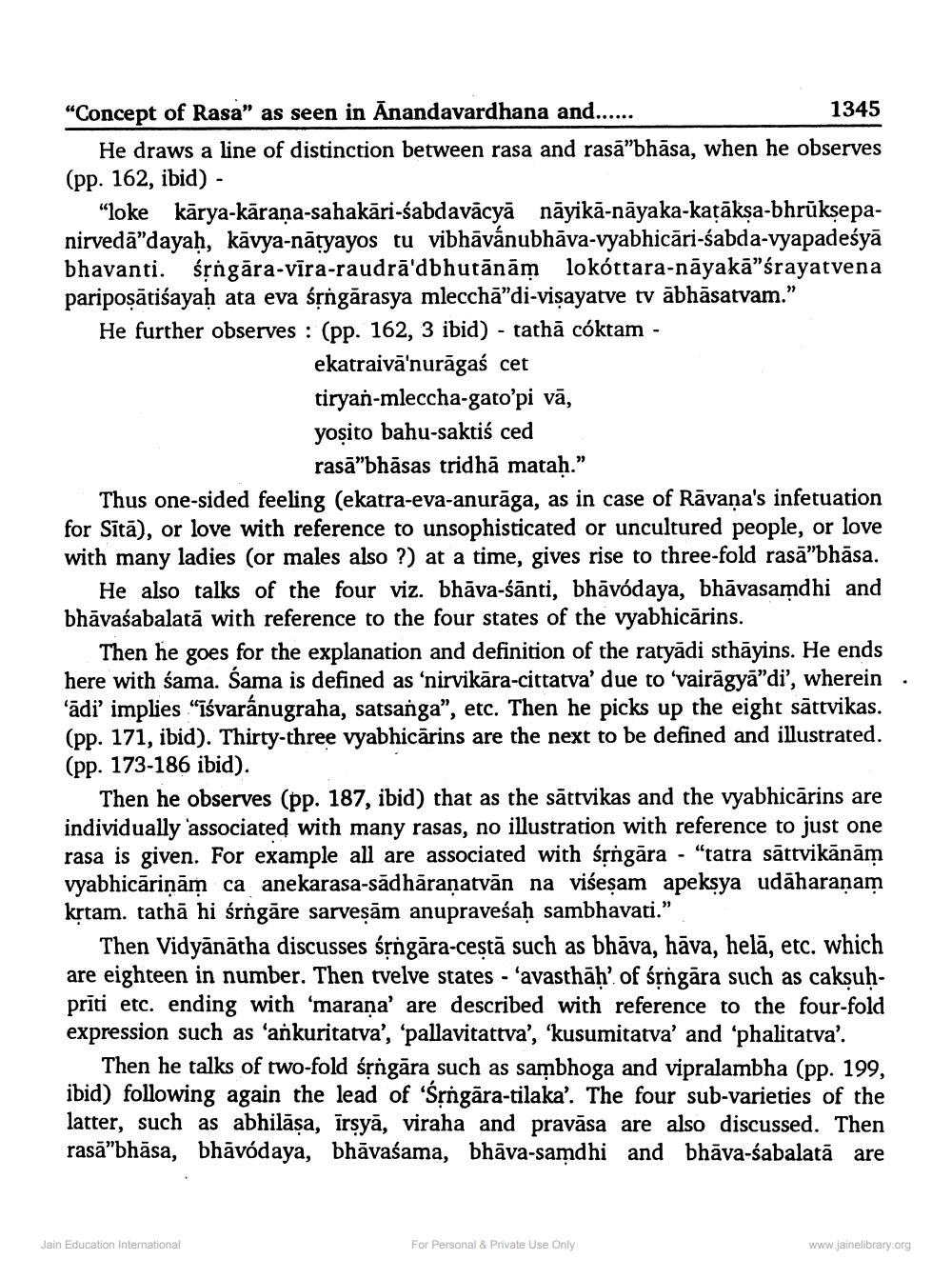________________
"Concept of Rasa" as seen in Anandavardhana and......
1345 He draws a line of distinction between rasa and rasā”bhāsa, when he observes (pp. 162, ibid) -
"loke kārya-kāraṇa-sahakāri-sabdavācyā nāyikā-nāyaka-kațākṣa-bhrūksepanirvedā"dayaḥ, kāvya-nāryayos tu vibhāvánubhāva-vyabhicāri-sabda-vyapadeśyā bhavanti. śrngāra-vīra-raudrā'dbhutānām lokóttara-nāyakā"śrayatvena paripoșātiśayah ata eva śộngārasya mlecchā”di-visayatve tv ābhāsatvam.” He further observes : (pp. 162, 3 ibid) - tathā cóktam -
ekatraivā'nurāgaś cet tiryan-mleccha-gato’pi vā, yoșito bahu-saktiś ced
rasā"bhāsas tridhā matah." Thus one-sided feeling (ekatra-eva-anurāga, as in case of Rāvana's infetuation for Sītā), or love with reference to unsophisticated or uncultured people, or love with many ladies (or males also ?) at a time, gives rise to three-fold rasā”bhāsa.
He also talks of the four viz. bhāva-śānti, bhāvódaya, bhāvasamdhi and bhāvaśabalatā with reference to the four states of the vyabhicārins.
Then he goes for the explanation and definition of the ratyādi sthāyins. He ends here with sama. Sama is defined as ‘nirvikāra-cittatva' due to 'vairāgyā”di', wherein.
īśvaránugraha, satsanga”, etc. Then he picks up the eight sāttvikas. (pp. 171, ibid). Thirty-three vyabhicārins are the next to be defined and illustrated. (pp. 173-186 ibid).
Then he observes (pp. 187, ibid) that as the sātrvikas and the vyabhicārins are individually associated with many rasas, no illustration with reference to just one rasa is given. For example all are associated with śrngāra - "tatra sātrvikānām vyabhicāriņām ca anekarasa-sādhāraṇatvān na višesam apeksya udāharanam krtam. tathā hi śrngāre sarvesām anupraveśaḥ sambhavati."
Then Vidyānātha discusses śrngāra-cestā such as bhāva, hāva, helā, etc. which are eighteen in number. Then tvelve states - ‘avasthāḥ of śộngāra such as cakṣuḥprīti etc. ending with 'marana' are described with reference to the four-fold expression such as ‘ankuritatva', 'pallavitattva', 'kusumitatva' and 'phalitatva'.
Then he talks of two-fold śộngāra such as sambhoga and vipralambha (pp. 199, ibid) following again the lead of 'Srngāra-tilaka'. The four sub-varieties of the latter, such as abhilāșa, īrsyā, viraha and pravāsa are also discussed. Then rasā"bhāsa, bhāvódaya, bhāvasama, bhāva-samdhi and bhāva-babalatā are
Jain Education International
For Personal & Private Use Only
www.jainelibrary.org




